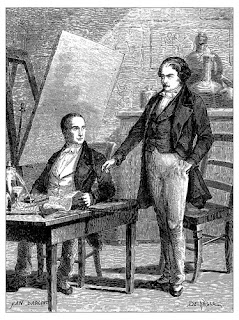Blog Post #4: EOTO Photography
Photography did not have one sole inventor. It took several artists and scientists to come together to create what we think of as photography. Henry Fox Talbot invented one of the first photographic processes knowns as the calotype. The calotype involved covering a paper with silver iodide to produce a translucent original negative image. This specific method allowed for multiple positives to be made by contact printing and was a small step forward for photography. However, Nicéphore Niépce an inventor from France, is considered to be the inventor of photography. Niépce had his own method of heliography, meaning "sun drawing," of taking a photograph that involved dissolving bitumen in lavender oil and covering it with a metal plate. When the photograph is dried the plate is covered with paper that had a drawing on it and left in the sun. Over time, unshielded bitumen would harden while the shielded was still soft and could be removed with solvent. Bare parts of the plate could then be drawn on with acid and the rest of the plate was used for printing. During this time, another french artist Louis Daguerre was experimenting with photography. He would soon create a partnership with Niépce to create a daguerreotype photographic process, which revolutionized photography.
In the more modern-day, the Eastern Kodak Company was the driving force in the worldwide boom of photography in the early 20th century. The company introduced many different films in rolls, sheets, and cameras for beginners, enthusiasts, and professional photographers. The invention of modern-day photography has completely changed the way our world functions. In a way, social media is built entirely on photography due to photographs in some instances having more impact than words have. For example, in the world of social media, everyone wants their information easy to interpret and quick, so it was successful when there is a photograph that can pull in a reader's attention.
Another way a photograph changes communication is by capturing scenes that can evoke emotions right off the bat and are a powerful visual aid. For example, everything with advertising is through photography and videography for a reason due to human nature having a natural pull towards it. Modern-day photography is also everywhere and almost everyone can take one due to most phones having a built-in phone. In comparison to when photography was first invented and only the wealthy families were able to participate. Additionally, there is no longer the issue of ruining a photograph with exposure to sunlight because of the advances that have since been made.
One of the negatives with photography is that it can be expensive if you are seeking out to be a professional photographer because of the equipment needed. Another negative about photography is that framing a subject could be misleading depending on the narrative you are trying to tell. For example, tabloids take misleading photographs of celebrities, constantly trying to frame them in a negative light for attention, which spreads false information and ruins people's livelihoods. However, this can be argued as a negative about the arts and entertainment industry rather than a negative on the actual invention itself.





Comments
Post a Comment